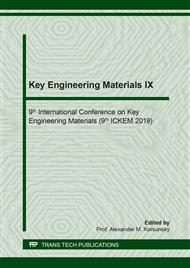p.183
p.189
p.195
p.201
p.209
p.215
p.222
p.229
p.237
The Effect of Variable-Frequency Ultrasonic Melting Treatment Technology on Microstructure and Properties of AZ80 Magnesium Alloy
Abstract:
The traditional fixed-frequency ultrasonic technology (FUT) and the variable-frequency ultrasonic technology (VUT) were used in direct-chill (DC) casting of an AZ80 magnesium alloy with the diameter of ∅255mm. The microstructure evolution, mechanical properties and macro-segment of Al element were investigated. The results show that both FUT and VUT can refine the α-Mg grain while the VUT has better efficiency which can reduce the grain size from 679-1454 μm (DC) to 150-241 μm. The homogeneity of grain size was also improved. These two technologies can also change the morphology and distribution of Mg17Al12 phase and tiny and refined morphology of Mg17Al12 phase and a homogeneous distribution can be obtained after VUT treatment. The YS and UTS were increased following the microstructure evolution, displaying the YS of 88.9-95.1 MPa and UTS of 164.3-173.1 MPa after VUT treatment. The segregation rate of Al element were improved with VUT treatment. Keywords: magnesium alloy; variable frequency ultrasonic technology; microstructure; mechanical properties;
Info:
Periodical:
Pages:
209-214
Citation:
Online since:
September 2019
Authors:
Price:
Сopyright:
© 2019 Trans Tech Publications Ltd. All Rights Reserved
Share:
Citation:


